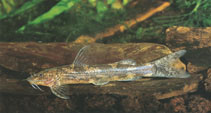| Diagnosis: |
Dorsal spines (total): 0-0; Dorsal soft rays (total): 7-7; Anal spines: 0-0; Anal soft rays: 8-11; Vertebrae: 31-33. Diagnosis: Amphilius jacksonii is diagnosed from all other species of the Amphilius jacksonii complex by its more slender caudal peduncle, 4.8-7.9% of standard length vs. 8.1-12.3% (Ref. 103388). It is further distinguished from A. pedunculus, A. frieli, and A. crassus by its longer caudal peduncle, caudal-peduncle length 16.7-20.6% of standard length vs. 13.3-18.8%; and from A. frieli, A. crassus, and A. lujani by its more slender body, body depth at anus 9.6-13.2% of standard length vs. 13.5-17.4% (Ref. 103388). It is further distinguished from A. frieli by having fewer total gill rakers on the first gill arch, 6-9, rarely 10 vs. 10-11, rarely 9 or 12; and from A. ruziziensis by having a wider interorbital width, 26.7-32.0% of head length vs. 23.4-25.1% (Ref. 103388). It differs from other east and southern African species of Amphilius, including the wide ranging A. uranoscopus, in having fewer total vertebrae, a mode of 6+7 principal caudal rays, and a crenulated epidermal fold at the base of the caudal fin; the latter character is shared with A. platychir and at least some other west African Amphilius species (Ref. 51677). Amphilius jacksonii is further characterized by the following combination of characters (but not all unique): dorsal and pectoral spines absent; dorsal fin with 7 soft rays; short adipose fin not adnate with caudal fin; pectoral fin with 8-10 soft rays; anal-fin rays 7-10; forked caudal fin with rounded lobes; 31-33 free vertebrae; and variable, heavily mottled pigmentation (Ref. 51677). It is distinguished from other congeners in the Congo [=Zaire] River, except A. angustifrons and A. notatus, by having fewer total free vertebrae, 31-33 vs. 33-40; from A. angustifrons and A. notatus it is distinguished by fewer pectoral rays, 8-11, mode of 10, vs. 8-9, mode of 9; anal-fin rays, mode of 10 vs. 9; and mensural characters (Ref. 51677).
Description: Body elongate; ventral profile flattened ventrally to anal-fin base, then tapered dorsally to end of caudal peduncle; dorsal profile rising gently from tip of snout to origin of dorsal fin, then nearly horizontal to end of caudal peduncle; greatest body depth at dorsal-fin origin (Ref. 103388). Caudal peduncle laterally compressed, with crenellated epidermal fold; anus and urogenital opening located at midpoint of adpressed pelvic fin, closer to pelvic-fin insertion than to origin of anal fin (Ref. 103388). Skin smooth; lateral line complete, extending from dorsal edge of opercular cavity to caudal-fin base (Ref. 103388). Head and anterior part of body depressed and broad; head wedge-shaped in lateral view; snout broad, blunt when viewed from above; head becoming wider from tip of snout to pectoral-fin base; branchiostegal membranes moderately joined at isthmus forming a U-shaped connection (Ref. 103388). Mouth broad, gently curved, subterminal; lips moderately fleshy, slightly papillate; rictal lobe large and papillate; anterior portion of premaxillary tooth band exposed with mouth closed; premaxillary tooth patches joined, forming V-shaped band with anterior broad protrusion; premaxillary and dentary teeth short, conical; dentary tooth patches forming U-shaped band, separated medially (Ref. 103388). Three pairs of simple, tapered circumoral barbels; maxillary barbel large, fleshy and flattened with pointed tip; barbel extending posterolaterally from corner of mouth to pectoral-fin base; outer mandibular barbel thin with pointed tip, origin at posterior corner of lower jaw, extending to pectoral-fin origin; inner mandibular barbel originates anterolaterally of outer mandibular barbel, extending to edge of branchiostegal membrane (Ref. 103388). Branchiostegal membrane with 6-9 rays; gill rakers on first epibranchial 1-3; rakers on first ceratobranchial 4-8; total gill rakers on first arch 6-10 (Ref. 103388). Eye small, positioned dorsolaterally approximately midway between tip of snout and posterior margin of operculum; horizontal diameter of eye slightly wider than vertical diameter; eye without free orbit, covered with skin confluent with dorsal surface of head; anterior and posterior nares with prominent tubular rims; nares separate but relatively close to each other; posterior nare located about midway between eye and tip of snout (Ref. 103388). Dorsal-fin origin at point over tip of adpressed pectoral fin; dorsal fin with i,6 rays, margin straight; pectoral fin with i,7-9 rays; unbranched ray greatly thickened; pectoral fin with four or five innermost rays progressively shorter making posterior fin margin rounded; origin of pelvic fin posterior to dorsal-fin insertion; pelvic fin with i,5 rays with first ray unbranched and greatly thickened; pelvic fin with straight posterior margin (Ref. 103388). Adipose-fin base longer than anal-fin base, origin anterior to origin of anal-fin base; fin extending past anal-fin insertion; margin strongly convex with sharply rounded edge, not deeply incised posteriorly; caudal fin deeply forked with tips of lobes rounded; fin with i,5-6,5-6,i principal rays; anal fin with short base, origin posterior to origin of adipose-base, with ii-iv,6-8 rays; anal-fin margin almost straight (Ref. 103388).
Colouration: Body variably mottled and with dark saddles; first saddle immediately posterior of head, second saddle under dorsal fin, third saddle between dorsal and adipose fins, fourth saddle under anterior part of adipose fin, and fifth saddle on caudal peduncle; all saddles connected laterally by broad stripe; venter light brown with fourth and fifth saddles meeting those of opposite side (Ref. 103388). Dorsal and anal fins light brown with dark medial band; adipose fin dark brown, cream-coloured distally; pectoral and pelvic fins positioned horizontally with upper surfaces brown and lower surfaces light yellow, each with dark medial band; caudal fin brown with medial cream patch and tips of upper and lower lobes cream; caudal colouration asymmetrical, lower lobe with more pigment than upper lobe (Ref. 103388). |
